|
 Performance Support Performance Support
Performance Support
|
"The danger in leaping from apparent problem to apparent solution
is that large amounts of time and money can be spent in throwing training at a problem that training cannot solve. You need to dig a little deeper... This is why a procedure like performance analysis is important to those who actually want to solve problems
— rather than just talk about them. "
Robert Mager & Peter Pipe, Analyzing Performance Problems
|
What is Performance Support?
Performance Support (PS) refers to wide range of applications, processes and technologies designed to enhance performance in the workplace. It is also referred to as "human performance technology." Simply put, it is anything that helps a worker do their job easier and better. It may be having more effective tools, environmental design, having the requisite skills, knowing what is expected, or simply having the right information at the right time to do the right task.
A strong human systems view is needed — applying the best in cognitive and behavioral psychology — in order to establish an environment of management and communication "best practices," and to remove motivational and environmental obstacles. Effective worker performance requires clearly defined expectations, skills and ability to perform assigned tasks, a work environment free of obstacles, and motivation to do the work.
Stolovitch & Keeps (1999) define "Human Performance Technology" as the following:
- Human: Focus on on human performance in the workplace
- Performance: Behaviors that result in verifiable accomplishments
- Technology: Application of scientific and organized knowledge to solve practical problems
Performance can be improved by: increasing knowledge & skill (establish competence); removing environmental roadblocks (establish organizational alignment); providing tools & infrastructure (establish optimum task aides), or supporting motivation (establish willingness and commitment). Interventions may involve training, motivation, environment, tools, or a combination of all of these.
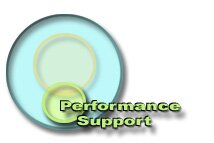 |
In the Cognitive Design Model, Performance Support is situated within the context of Knowledge Mgt. resources and E-Learning programs. Its role is to provides task support in the performance environment in order to strengthen transfer-of- learning. The keynote here is "guidance". Historically this area of "guidance" has been the domain of team managers — who provide mentoring, role-modeling, inspiration and leadership as part of their management-supervisory role. Today, a range of new tools support workflow learning and task automation that provide "guidance" within the task itself — to be invoked by the worker as needed. |
The importance of appropriate technology to support performance is that it can provide new efficiencies of communication and teamwork. It can introduce task automation that saves time and reduces errors. The value of training is that it presents the knowledge and skills required for a job. Yet, installing technology for technology's sake, or conducting training for training's sake, does not in itself identify or solve a performance problem. Performance analysis must precede and validate introduction of new technology or the role of training in solving a performance problem.
To achieve this goal there are at least four dimensions of a Performance Support strategy — each with different objectives and distinct methods & technology to improve task performance.
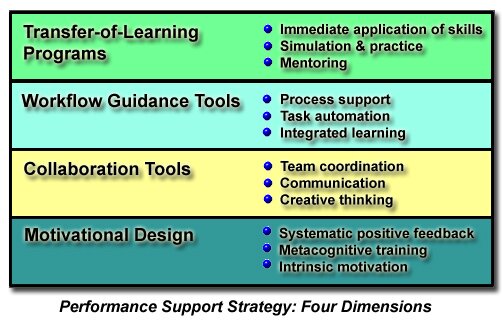
- Transfer-of-learning programs — enhance the immediate application of skills, knowledge and attitude gained from training, through activities such as simulation & practice, mentoring, and systematic positive feedback (flowing from both management and from peers)
- Workflow guidance tools — directly support performance quality and timeliness through Information-on-Demand applications, Task Wizards, Business process applications, "Watch and Learn" video models and interactive multimedia, and EPSS environments
- Collaboration tools — increase productivity by directly supporting and facilitating team coordination, communication, and creative thinking
- Motivational Design — establish policies and organizational structure that strengthen, rather than undermine, staff motivation; continuously remove organizational obstacles to workflow; utilize metacognitive training to enhance key skills in decision-making, planning, self-management, team communication collaboration (such as effective group meeting techniques) that enhance workflow and both individual and team creativity
|
"Pit a good employee against a bad system and
the system will win most every time "
Geary Rummler , "Training Skills Isn't Enough" (1983)
|
Key Definitions 
Performance
Analysis |
A “process by which you partner with clients to identify and respond to
problems and opportunities, and to study individuals and the organization to
determine an appropriate cross-functional solution system.”
Allison Rossett |
| Needs Analysis |
A “systematic study that incorporates data and opinions from varied sources
in order to create, install, and evaluate educational … products and services.”
Allison Rossett |
Performance
Gap |
“A discrepancy (gap) is a difference … between what is and what should be. … Human performance discrepancies [are] those differences between what people are actually doing … and what they should be doing.”
Robert Mager & Peter Pipe |
| Task Analysis |
A “step-by-step description of what a competent person does when
performing a relatively sequential task, whether the steps of that task are
mainly cognitive (mental) or psychomotor (physical). It is a way of making
competent performance visible, much as a blueprint provides a way to make
the components of a finished product visible.”
Robert Mager |
| Goal Analysis |
A process to “define the indefinable … to help you say what you mean by
your important but abstract goals. …to identify the main performances that
constitute the meaning of the goal. Once you know the performances that
collectively define the goal, you will be in a better position to decide which of
these performances need to be taught and which need to be managed.”
Robert Mager |
Performance Problems & Solutions 
The following table provides a quick overview of some of the possible performance problem causes and solutions:
|
Performance Problem Cause
|
Possible Solutions
|
|
Environment Support:
Does the employee have the resources to do the job?
|
Flexibility with schedule and job duties, availability of tools, reorganization of workplace.
|
|
Organization Support :
Is the organization preventing performance?
|
Incentive programs and appraisal process, change in policy, collaboration tools
|
|
Management Support:
Is the employee aware of what is expected?
|
Expectations, resources, feedback, coaching
|
|
Knowledge and Skills
Can the employee do the job?
|
Instruction, coaching, job aids, documentation, transfer-of-learning tasks, workflow guidance applications and electronic support systems.
|
|
Motivation:
Will the employee do the job?
|
Information, coaching, incentive systems, appraisal process, team-building, training in self-management and intrinsic motivation skills.
|
A systematic approach to Performance Support begins with performance analysis, and then can engage a broad strategy that may include: transfer-of-learning programs, workflow guidance tools, collaboration tools and motivational design.
The focus is on the solution — system re-design, environmental engineering — not on the problem. That is the primary distinction between reactive, crisis management versus proactive, agility-oriented management. Performance Support focus is on the outcome, not simply on activity. For instance, training is only one method among many to impact learning and motivation. Training is a response, not the goal. The goal is performance improvement.
| Know the Business |
Know your client's business. what are their objectives? What are their challenges? What do they value? |
| Define the Gap |
Document the difference between optimal and actual. What should happen? What does happen? How do you know? Who wants it solved? |
| Clarify the Costs |
Identify the price of the problem. What is lost if nothing is done? What is gained if we fix it? |
| Look for Causes, Enablers & Obstacles |
Question the assumptions and potential solutions. What is causing the problem? What will prevent a solution? What will make a solution easier? |
| Focus on Key Sources |
Find and focus on the people who are close to the problem and have
perspective on the issues. Don’t try and reach everyone – especially in a performance analysis. |
| Focus on Facts & Results |
Look for data, through observations, records, experiences. What evidence is there? Is it consistent? What does it tell us? Is there more? |
The Performance/Learning Cycle 
A Performance Support model aimed at strengthening task performance is shown in the following graphic — called the "performance/learning cycle" by Ariel Systems. Key workflow functions required daily are: Referencing, Learning, Doing, and Collaboration. Tools and resources which increase efficiency and effectiveness in these functions improves worker productivity. Collaboration plays a central role in making the other elements more successful. Software applications can target each of the issues highlighted here.

This model illustrates the value of a software environment to provide essential resources, communication and task processing tools. Ideally, the software environment provides a platform that integrates these fundamental functions — embedding learning and performance support seamlessly into the task workflow.
Analyzing Performance Problems 
Robert Mager and Peter Pipe, authors of Analyzing Performance Problems, (3rd ed, 1997) make the following observation:
"People don't perform as desired for many reasons; for example,
(a) they don't know what's expected;
(b) they don't have the tools, space, authority;
(c) they don't get feedback about performance quality;
(d) they're punished when they do it right;
(e) they're rewarded when they do it wrong;
(f) they're ignored whether they do it right or wrong; and
(g) they don't know how to do it."
The Mager and Pipe book offers a flowchart of steps and commentary outlining the analysis of performance problems. Robert Mager is one of the most important pioneers of the modern training industry. Mager has been relentless in his critique of misdirected management and training interventions to solve performance problems.
"People do things for the strangest reasons. For equally strange reasons, they also don't do things.... If we label others as having poor attitude and lack of motivation, we are finger-pointing, naming a culprit and hinting at a solution instead of probing for the problem by asking, 'Why is this so? What causes it?' Similarly, we jump the gun if we look at inadequate performance and declare, 'We've got a training problem.' Again, this confuses problem and solution. Training isn't a problem; it's just one of the solutions used to solve problems that arise when people truly cannot do what is expected of them."
|
Mager & Pipe Checklist (1997 — adapted)
Performance Analysis Questions
|
|
Key Questions
|
Probe Questions
|
|
I. They are not doing what they should be doing.
 I think I've got a training problem. I think I've got a training problem.
|
|
1. What is the performance discrepancy?
(Describe actual & desired performance —
Are the expectations for perfromance clear? )
|
 Why do I think there is a training problem? Why do I think there is a training problem?
 What is the difference between what is being done and what is supposed to be done? What is the difference between what is being done and what is supposed to be done?
 What is the event that causes me to say that things aren’t right? What is the event that causes me to say that things aren’t right?
 Why am I dissatisfied? Why am I dissatisfied?
|
|
2. Is it important?
(Is it worth pursuing; what evidence suggest that it is? If not, drop it.)
|
 Why is the discrepancy important? Why is the discrepancy important?
 What would happen if I left the discrepancy alone? What would happen if I left the discrepancy alone?
 Could doing something to resolve the discrepancy have any worthwhile result? Could doing something to resolve the discrepancy have any worthwhile result?
|
|
3. Is it a skill deficiency?
|
 Could the person do it if really required to do it? Could the person do it if really required to do it?
 Could the person do it if his or her life depended on it? Could the person do it if his or her life depended on it?
 Are the person’s present skills adequate for the desired performance? Are the person’s present skills adequate for the desired performance?
|
|
II. Yes. It is a skill deficiency.
 They couldn't do it if their lives depended on it. They couldn't do it if their lives depended on it.
|
|
4. Could they do it in the past?
|
 Did the person once know how to perform as desired? Did the person once know how to perform as desired?
 Has the person forgotten how to do what I want done? Has the person forgotten how to do what I want done?
|
|
5. Is it the skill used often?
(Are performance consequences and feedback used effectively?)
|
 How often is the skill or performance used? How often is the skill or performance used?
 Is there regular feedback on performance? Is there regular feedback on performance?
 Exactly how does the person find out how well he or she is doing? Exactly how does the person find out how well he or she is doing?
|
|
6. Is there a simpler solution?
(Can the task be made easier?)
|
 Can I change the job by providing some kind of job aid? Can I change the job by providing some kind of job aid?
 Can I store the needed information some way (in written instructions, checklists) other than in someone’s head? Can I store the needed information some way (in written instructions, checklists) other than in someone’s head?
 Can I show (demonstrate) rather than train? Can I show (demonstrate) rather than train?
 Would informal (such as on-the-job) training be sufficient? Would informal (such as on-the-job) training be sufficient?
|
|
7. Do they have what it takes?
(Does the person have the potential to do the task?)
|
 Could the person learn the job (is the Could the person learn the job (is the
individual trainable)?
 Does this person have the physical and mental potential to perform as desired? Does this person have the physical and mental potential to perform as desired?
 Is this person over-qualified for the job? Is this person over-qualified for the job?
|
|
III. Is it not a skill deficiency.
 They could do it if they wanted to. They could do it if they wanted to.
|
|
8. Is the desired performance punishing?
|
 What is the consequence of performing as desired? What is the consequence of performing as desired?
 Is it punishing to perform as expected? Is it punishing to perform as expected?
 Does the person perceive desired performance as being geared toward penalties? Does the person perceive desired performance as being geared toward penalties?
 Would the person’s world become little dimmer if the desired performance were attained? Would the person’s world become little dimmer if the desired performance were attained?
|
|
9. Is non-performance rewarding?
|
 What is the result of doing it the present way instead of my way? What is the result of doing it the present way instead of my way?
 What does the person get out of the present performance in the way of reward, prestige, status, jollies? What does the person get out of the present performance in the way of reward, prestige, status, jollies?
 Does the person get more attention for misbehaving than behaving? Does the person get more attention for misbehaving than behaving?
 What event in the world supports (i.e. rewards) the present way of doing things? (Am I inadvertently rewarding irrelevant behavior while overlooking the crucial behaviors?) What event in the world supports (i.e. rewards) the present way of doing things? (Am I inadvertently rewarding irrelevant behavior while overlooking the crucial behaviors?)
 Is this person "mentally inadequate," doing less so that there is less to worry about? Is this person "mentally inadequate," doing less so that there is less to worry about?
 Is this person physically inadequate, e.g., doing less because it is less tiring? Is this person physically inadequate, e.g., doing less because it is less tiring?
|
|
10. Does performing really matter to them?
|
 Does performing as desired matter to the performer? Does performing as desired matter to the performer?
 Is there a favorable outcome for performing? Is there a favorable outcome for performing?
 Is there an undesirable outcome for not performing? Is there an undesirable outcome for not performing?
 Is there a source of satisfaction for performing? Is there a source of satisfaction for performing?
 Can this person take pride in this performance as an individual or as a member of a group? Can this person take pride in this performance as an individual or as a member of a group?
 Is there satisfaction of personal needs from the job? Is there satisfaction of personal needs from the job?
|
|
11. Are there obstacles to performing?
(Are the resources adequate?)
|
 What prevents this person from performing? What prevents this person from performing?
 Does the person know what is expected? Does the person know what is expected?
 Does the person know what to do what is expected? Does the person know what to do what is expected?
 Does the person know when to do what is expected? Does the person know when to do what is expected?
 Are there conflicting demands on this person’s time? Are there conflicting demands on this person’s time?
 Does the person lack Does the person lack
 the authority? the authority?
 the time? the time?
 the tools? the tools?
 Are there restrictive policies, or a "right way of doing it," or a "way we’ve always done it" that ought to be changed? Are there restrictive policies, or a "right way of doing it," or a "way we’ve always done it" that ought to be changed?
 Can I reduce interference by Can I reduce interference by
 improving lighting? improving lighting?
 changing colors? changing colors?
 increasing comfort? increasing comfort?
 modifying the work position? modifying the work position?
 reducing visual or auditory distractions? reducing visual or auditory distractions?
 Can I reduce "competition from the job" – e.g., phone calls, "brush fires", demands of less important but more immediate problems? Can I reduce "competition from the job" – e.g., phone calls, "brush fires", demands of less important but more immediate problems?
|
|
IV. What should I do now?
|
|
12. Which solution is best?
|
 Have all the potential solutions been Have all the potential solutions been
identified?
 Does each solution address itself to one or more problems identified during the analysis (such as skill deficiency, absence of potential, Does each solution address itself to one or more problems identified during the analysis (such as skill deficiency, absence of potential,
incorrect rewards, punishing consequences, distracting obstacles)?
 What is the cost of each potential solution? What is the cost of each potential solution?
 Have the intangible (unmeasurable) costs been assessed? Have the intangible (unmeasurable) costs been assessed?
 Which solution is most practical, feasible, and economical? Which solution is most practical, feasible, and economical?
 Which solution will add most value (solve the largest part of the problem for the least effort)? Which solution will add most value (solve the largest part of the problem for the least effort)?
 Which remedy is likely to give us the most result for the least effort Which remedy is likely to give us the most result for the least effort
 Which solution are we best equipped to try? Which solution are we best equipped to try?
 Which remedy interests us most? Which remedy interests us most?
(Or, on the other side of the coin, which
remedy is most visible to those who
must be pleased?)
|
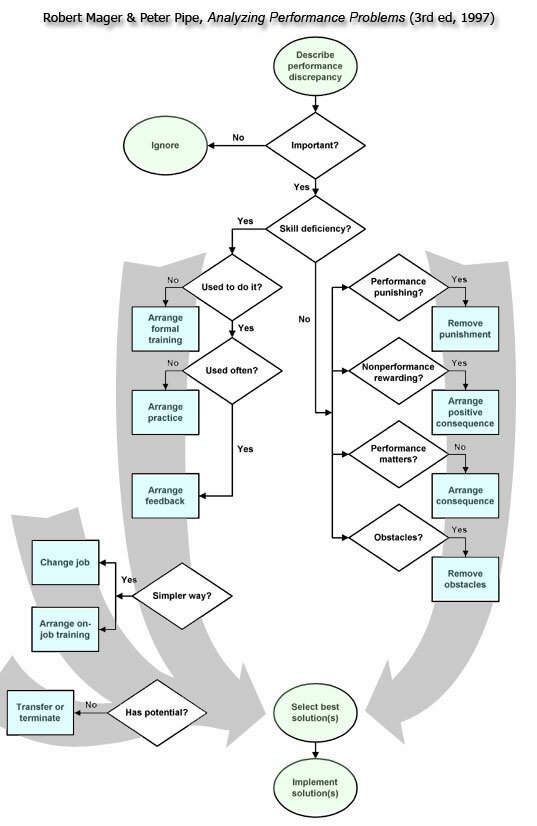
Meaningful Metrics 
Management, executive and operational, cannot objectively manage what it cannot define and measure. The use of metrics is an essential element in a scientific approach to management. Measurement brings clarity and discipline in defining work performance objectives, impactful training objectives, and systematic monitoring & feedback of key performance indicators (KPI). These metrics make business trends visible, as well as the consequences of decisions and policy.
"Business Activity Monitoring (BAM) refers to the aggregation, analysis, and presentation of relevant and timely information
about business activities inside organizations and involving customers and partners. BAM provides more accurate information about the status and results of various operations, processes,
and transactions so business decisions can be informed,
quickly address problem areas, and reposition organizations
to take full advantage of emerging opportunities."
Wikipedia: Business Activity Monitoring
|
ROI for programs and projects will make reference not only to financial but non-financial metrics. For more information about this, see the sections in this web site called Alignment and Balanced Scorecard. Business Intelligence Dashboards are an increasingly popular software tool that provides executives, managers, departments and teams with a visual representation of metrics being monitored (interval and real-time). This is described and illustrated in more detail in the section, KPI, Metrics & Dashboard.
An organization must know what they are going to measure and how they are going to use those measures. Organizations typically implement three levels of metrics:
- Workplace — allocations, job definition, products and customer profiles
- Work — functional standards, workflow automation, team processes
- Worker — activities (including training and incentives)
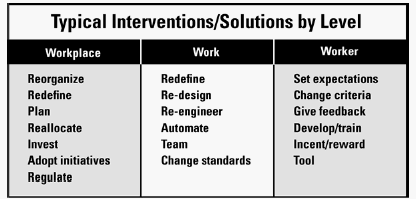
Workplace metrics can include: satisfaction, processes, compliance, performance, finances and market demands.
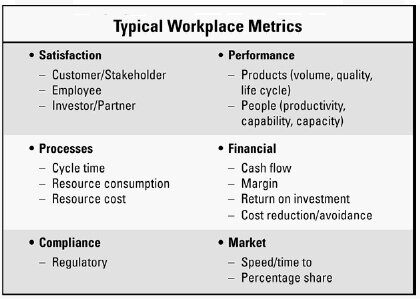
Work metrics can include: input, process, output, outcome and fallout.
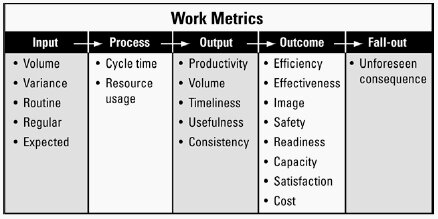
Worker metrics can include:
- clarifying and communicating expectations,
- changing hiring and performance criteria,
- establishing more timely feedback
- employee development through training, coaching, mentoring, and rewarding behaviors & results through incentives.
Measurement typically involves a three phase model: pre- (measure need), implementation (measure in-process), and post- (measure results).
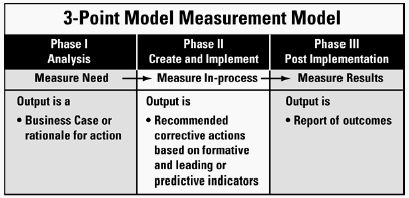
Transfer of Learning 
The first dimension of a Performance Support strategy is to enhance transfer-of-learning. This is a primary objective of all training — especially E-Learning. Transfer-of-learning seeks to have each learner immediately apply new knowledge from training into the actual performance environment — whether that is at work, school, or home.
Most traditional training programs do not include a systematic plan for practice, reinforcement, mentoring or feedback to ensure that learning transfer (from the classroom to the "real world") will take place — so that skills will be strengthened in the natural setting. Traditional training has been a "classroom only" activity that stops at the classroom door. This is one of the most obvious failings or short-comings of traditional training approaches. The perspective of Performance Support changes all that. Learning is seen as integral to workflow, and is a part of each and every job description. An essential role of the manager or team leader is to be a teacher-mentor dedicated to quality assurance and performance improvement.
The best team leaders have found that mentoring their team members after formal training — through role-modeling and providing positive feedback as new knowledge and skills are applied — can produce dramatic results in productivity. A follow-through performance support program can make training dollars have real impact. However, successful mentoring and systematic positive reinforcement requires specific expertise that managers or team leaders must first acquire.
Currently, a revolution in training is occurring as new software tools for task simulation and practice are being created. These provide concrete learning experiences that bridge between the 'training environment' and the 'work environment'. Since so much knowledge work uses software, simulation of these software tasks is a powerful instrument of transfer-of-learning. Further, the simulation and "watch and learn" video examples can be integrated into a software's help facility so that it is constantly available to the user.
Workflow Guidance 
The second dimension of PS is to provide a technology environment that supports performance directly through workflow guidance tools . Workflow applications links people to processes, information and knowledge. Often performance can be improved simply by providing needed information in the exact sequence of a task. Performance is also improved by reducing complexity or the number of steps involved in a task. The development of intranet and web-based business applications have been dramatically improving business productivity.
Workflow guidance tools can include technologies such as:
- Online help documentation and FAQ — integrated interactive multimedia guides and "watch and learn" video models
- Information-on-demand applications — via desktop applications, internet portals, intranet and extranet web applications
- Dedicated business process applications,
- Information-and-referral automation
- Business intelligence dashboards
- Automated report generation
- Decision-support applications and software "Wizards" that prompt and guide a user into correct performance of a task or business process
- Electronic performance support systems (EPSS), decision-support applications
Rick Gessner, founder of Eventropy, has proposed the following model of workflow milestones that provide critical factors in organizational effectiveness, and he has engineered a software environment, called Enfolio™ to implement this workflow and team collaboration model.
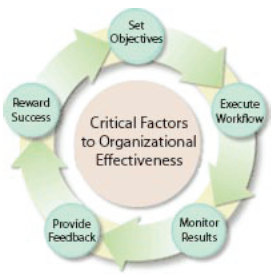
Enfolio™ is an integrated online environment that provides a set of customizable individual and team tools for project and business process workflow execution. The software has been designed to focus and coordinate team members and managers in workflow guidance.
Team Collaboration 
The third dimension of PS is to enhance team management and productivity through the use of collaborative environments and tools. These tools are often based on improving the communication and coordination among team members. This can include various technologies such as Groupware applications, online meeting environments, web casts, chat, threaded discussion, e-mail, instant messaging and other peer-to-peer applications. All of these tools enhance one-to-one or team collaboration. They provide workflow alternatives, enhance the speed of communication, and significantly reduce the time/logistical cost spent in physical team meetings. These tools and technologies strengthen the social network by which workflows and business processes are accomplished.
Motivational Design 
|
"An empowered organization is one in which individuals have the knowledge, skill, desire, and opportunity to personally succeed
in a way that leads to collective organizational success. "
Stephen R. Covey , Principle Centered Leadership
|
A fourth dimension of Performance Support strategy focuses on motivational engineering. The goal is to solve performance problems which are not merely based on knowledge and skill deficits, but may be based in motivation deficits.
Performance Support systematically disseminates and applies the knowledge and "best practices" that has been developed within the enterprise. Performance Support can impact diverse areas of organizational development such as team motivation, human factors, task analysis, and employee selection (recruitment, hiring, and succession planning).
Engineering motivational solutions involves factors both in the individual and in the environment.
- There may be a need for incentive systems, increased social reinforcement or a social milieu of team support in order for the desired performance to be initiated or maintained.
- There may be a need to re-engineer to the social network by installing new communication and collaboration tools, and by implementing specific "best practices" to improve workflow.
- There may be a need to resolve self-esteem issues that undermine intrinsic motivation. Knowledge workers particularly require high levels of intrinsic motivation in order to be productive. Attitudes change through new skills of self-management.
- There may be a need to develop new and higher capacities for intrinsic motivation through learning metacognitive skills. These metacognitive skills free the individual from excessive dependence on external incentives through internal monitoring and goal setting.
In all of these examples, use of collaboration tools enhances communication flow, social reinforcement, and metacognitive skill development. Communication loops can be designed and programmed to unleash the power of social networking — enhancing individual and team performance.
Kenneth Thomas in his important book, Intrinsic Motivation at Work (2000), emphasizes that self-managed work depends upon feedback loops of aware intention and monitoring of results.

Thomas has documented that motivational energy is dynamically unleashed through aware recognition and valuing of four primary "intrinsic rewards": a sense of choice, a sense of meaningfulness, a sense of competence and a sense of progress. His model can be understood as describing a metacognitive skill set that makes the fundamental tasks of self-management more effective:
- Choosing Activities
- Committing to Purpose
- Monitoring Competence
- Monitoring Progress
Kenneth Thomas proposes a diagnostic framework for each intrinsic reward by looking at the organizational environment. He argues that we have to go beyond job design:
"There are basic ambiguities in many events that allow them to be interpreted in various ways. Human behavior, we realize now, is shaped more directly by our interpretation of those events than by the events themselves. So we pay a great deal more attention now to how people interpret events — how they 'frame' events and 'construct' meaning. For example, it is clear that transformational or inspirational leaders are effective because they actively shape people's interpretations of the task purpose." (p. 49)
This model serves as a guideline for motivational engineering within an enterprise or within a team:
The over-arching goal of motivational design to establish a powerful alignment of each individual's values and commitment to action with the organization or team values and commitment to action.
EPSS: Electronic Performance Support System 
An Electronic Performance Support System (EPSS) is any computer software program or component that improves employee performance by:
- reducing the complexity or number of steps required to perform a task,
- providing the performance information an employee needs to perform a task, or
- providing a decision support system that enables an employee to identify the action that is appropriate for a particular set of conditions.
Electronic Performance Support Systems seek to reduce the cost of training staff while increasing productivity and performance. It seeks to empower an employee to perform tasks with a minimum amount of external intervention or training. By using this type of system an employee, especially a new employee, will not only be able to complete their work more quickly and accurately, but they will also learn more about their job and their employer's business by simply using the system.
The concept and vision of EPSS was first elaborated by Gloria Gery in 1991 through her landmark book Electronic Performance Support Systems:
"an integrated electronic environment that is available to and easily accessible by each employee and is structured to provide immediate, individualized on-line access to the full range of information, software, guidance, advice and assistance, data, images, tools, and assessment and monitoring systems to permit job performance with minimal support and intervention by others."
The EPSS concept is the most elaborate example of the use of technology to achieve performance support, and it typically involves an integration of several technologies to create an over-all enhancement of the workflow or business process. Components may include the following functions:
- An "advisor" to provide advice via expert systems and knowledge-base systems — including decision-support wizards
- An "assistant" to provide tools, workflow step guidance, and on-line help
- A "librarian" to make available reference and information databases (to satisfy the need for information-on-demand)
- A "teacher" to provide WBT or CBT components when the user is ready to use them — especially making interactive multimedia easy to use and integrated into the workflow environment.
Workflow Learning 
The Workflow Learning Institute (http://www.workflowinstitute.com/) is a new organization founded by Jay Cross, Gary Dickelman, Gloria Gery, and Clark Quinn. It seeks to promote the emerging field of "workflow learning" as the convergence of work and learning.
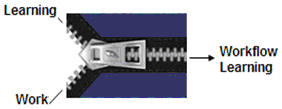
Sam Adkins in his white paper, "The Four Levels of Workflow Learning: An Introduction to Workflow Learning" (2004) offers the following definition:
"Workflow learning is task and decision support content that is accessed in real-time contextual workflow. It falls into two primary categories and can be segmented into four levels. The two primary categories of workflow learning are: highly automated — choreographed by computer-based workflow applications, and semi-automated — choreographed by human-based workflow. The four levels are: one, fused workflow learning; two, embedded tightly-integrated workflow learning; three, loosely-integrated workflow learning; and four, augmented workflow learning."
The Institute provides three graphics which illustrate the significance of this definition.
The first graphic, here, shows the pervasive impact of Business Processes which extend through four main categories of enterprise activity:
- Resource management,
- Collaboration management,
- Process management and
- Product management.
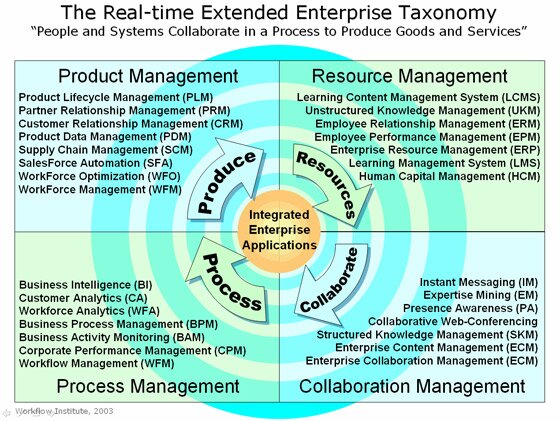
Software augments the business process "best practices" that are represented by each acronyms in the quadrants. Numerous software vendors focus product-solutions in each of these categories.
The second graphic shows how the four levels of workflow learning can be applied to each of the four business process domains to analyze their role and effectiveness. This provides an model to understand how software applications can integrate workflow and learning needs to achieve optimum end-user performance.
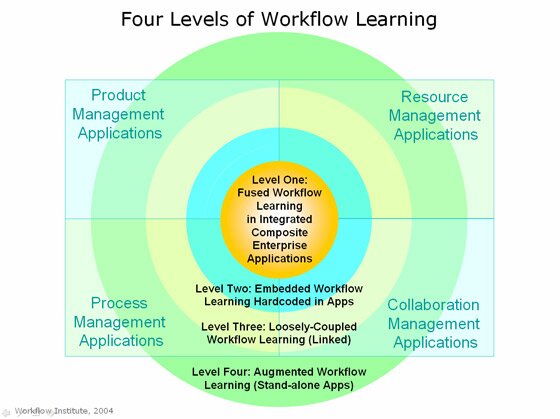
The definition of four levels of workflow aligns closely with the US Department of Defense (DoD) existing categories — which also adds a paper based product category to the digital-software categories.
The final graphic illustrates the typical way in which software augments the workspace of workers who use software for for various tasks that includes real-time learning to optimize productivity.

PS Architecture 
Standard internet and intranet IT infrastructure is required for workflow guidance and collaboration solutions. Fortunately, the current adoption of intranet client-server environments in business, government and education is now almost universal. So the ability to adopt performance support solutions is as much a function of upper management vision and understanding, as it is a budget for investing in new technology. Improving transfer-of-learning depends more on engineering the human systems than on the use of innovative software.
Specific software tools have been developed for each of the performance support components that we have enumerated, and new software tools are being constantly developed.
Benefits 
In the Cognitive Design model, Performance Support relates to solutions that provide guidance as distinct from those solutions that are based on providing information (Knowledge Management) or instruction (E-Learning). Without Performance Support, neither KM nor E-Learning can have sufficient or enduring impact on an enterprise.
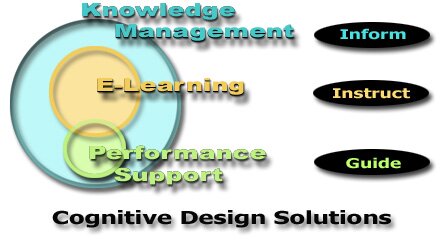
Performance Support adds its own distinct strategies. However, at the same time, it depends upon the information technology environment established by KM. Further, Performance Support grounds the learning strategies introduced by E-Learning into ongoing, daily performance improvement.
Technology Overview 
Various kinds of technology strengthen employee performance. These include simulation-practice, workflow tools and collaboration tools. Some solutions involve introduction of communication media. Other solutions involve elaborate EPSS business applications and embedded workflow learning applications to create a new and more efficient business process environments.
Some of the current technologies utilized by Performance Support strategies include the following:
- Business applications that provide information-on- demand
- Online help documentation
- "Watch and Learn" video models
- FAQ and customer service databases
- Information-and-referral automation
- Portal sites
- Business process web applications
- Business intelligence dashboards
- Project management tracking & status reporting
|
- Issues tracking with automated alerts
- Automated report generation
- Job aids (print and screen access)
- Task Wizards
- Decision-support applications
- Groupware applications
- Help desk environments
- Online meeting environments
- Web casts
- IP Telephony
- Chat
- Threaded discussion
- E-mail
- Instant messaging
- Peer-to-Peer applications
|
PS References & Selected Bibliography 
Adkins, Sam. "The Four Levels of Workflow Learning: An Introduction to Workflow Learning." Internet Whitepaper, 2004 http://www.workflowinstitute.com/
Allee, Verna. The Future of Knowledge: Increasing Prosperity through Value Networks,
Butterworth-Heinemann Press, 2003.
Allee, Verna. The Knowledge Evolution: Expanding Organizational Intelligence,
Butterworth-Heinemann Press, 1997.
ASTD (American Society for Training & Development -- association of workplace learning
and performance professionals). http://www.astd.org
Ariel Performance Centered Systems. "Performance / Learning Cycle." Internet Whitepaper,
2004 http://www.arielpcs.com/
Clark, Ruth. Building Expertise: Cognitive Methods for Training and Performance Improvement.
Intl Society for Performance, 2nd Edition, 2003.
Davenport, Thomas. Process Innovation : Reengineering Work through Information
Technology, Harvard Business School Press, 1993.
Farrington, Jeanne & James Fuller. From Training to Performance Improvement.
Pfeiffer , 1999.
Gery, Gloria. Electronic performance support systems: How and why to remake the workplace
through the strategic application of technology (1st. ed.), Weingarten Publications, 1991.
Gery, Gloria. "Attributes and Behaviors of Performance-Centered Systems."
Performance Improvement Quarterly, Vol 8, Num 1, 1995.
Gery, Gloria. "At The Moment of Need: Directly Supporting Doing, Learning, Referencing &
Collaborating." Internet Whitepaper 2002. http://www.gloriagery.com/presentations.asp
Gery, Gloria. "Learning, Doing and Referencing." Online Learning 2003 Conference.
Los Angeles, September 23, 2003. http://www.gloriagery.com/presentations.asp
Gilbert, Thomas F. Human Competence: Engineering Worthy Performance (1978).
ISPI Tribute Edition, 1996.
International Society for Performance Improvement (ISPI). http://www.ispi.org
Labovitz, George & Victor Rosansky. The Power of Alignment: How Great Companies
Stay Centered and Accomplish Extraordinary Things, John Wiley, 1997.
Mager, Robert & Peter Pipe. Analyzing Performance Problems. Lake Publishing Co, 1997.
Center for Effective Performance: http://www.cepworldwide.com/index.html
Pfeffer, Jeffrey & Robert Sutton. The Knowing-Doing Gap: How Smart Companies Turn
Knowledge into Action, Harvard Business School Press, 2000.
Raybould, Barry. "Performance Support Engineering: An Emerging Development Methodology
for Enabling Organizational Learning." Performance Improvement Quarterly, Vol 8, Num 1,
1995.
Rosenberg, Marc. "Performance Technology, Performance Support, and the Future of Training:
A Commentary." Performance Improvement Quarterly, Vol 8, Num 1, 1995.
Rummler, Geary. "Training Skills Isn't Enough". Training, Vol 20, Num 8, pp 75-76, 1983.
Rummler, Geary & Alan Brache. Improving Performance: How to Manage the White Space in
The Organizational Chart. Jossey-Bass, 1995.
Stolovitch, H. D. & E.J. Keeps (Editors). Handbook of Human Performance Technology
(2nd Ed) Pfeiffer, 1999.
Tapscott, Don & Art Caston. Paradigm Shift: The New Promise of Information Technology
McGraw-Hill, 1993.
Thomas, Kenneth W. Intrinsic Motivation at Work: Building Energy and Commitment.
Berrett-Koehler Publishers, 2000.
Van Tiem , Darlene, James Moseley, & Joan Dessinger. Fundamentals of Performance
Technology (2nd Ed). ISPI, 2004.

|



